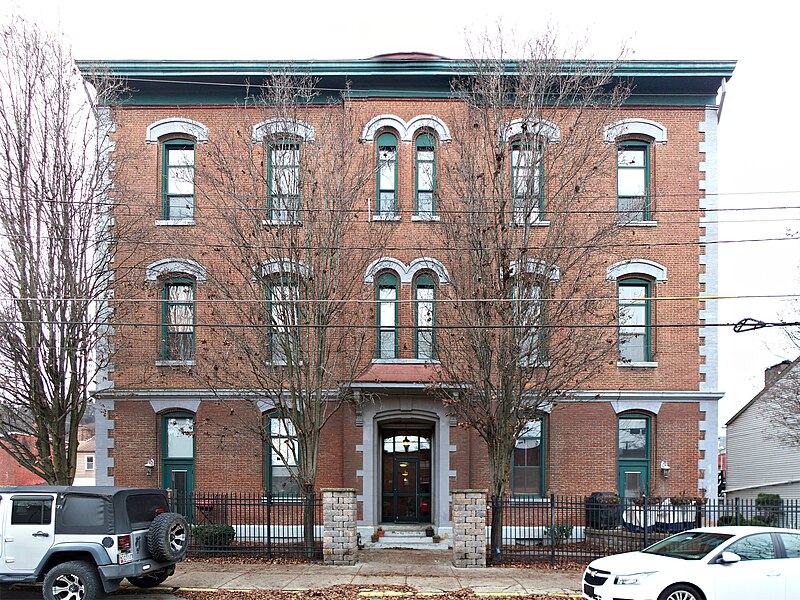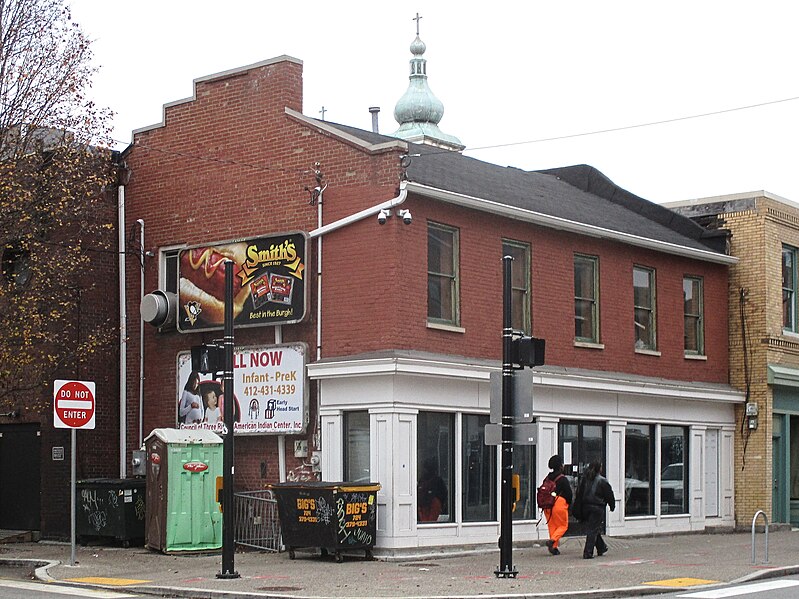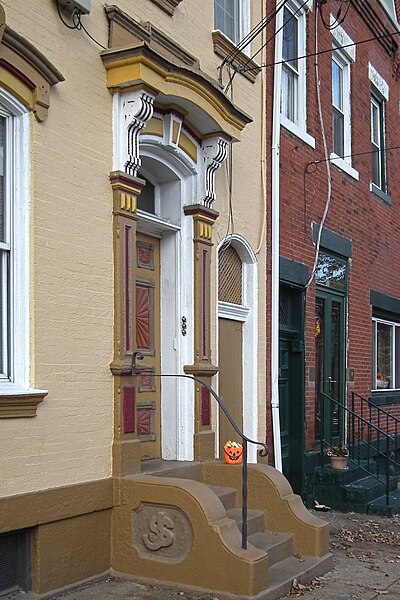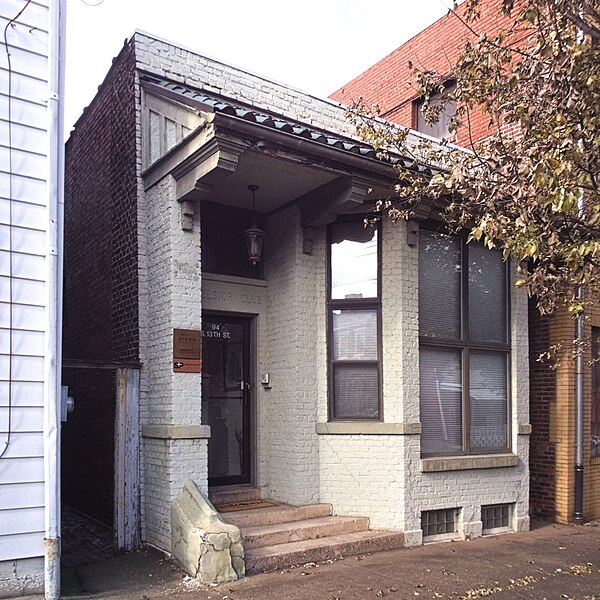
The stairway from the Smithfield Street Bridge down into the Grand Concourse of the Pittsburgh & Lake Erie railroad station.

All the South Side histories tell us that this school was originally built in 1871, the year before Birmingham was taken into the city of Pittsburgh as part of the South Side. From old maps, however, it appears that only the central part of the school, invisible from the street today, was built that early. The two identical fronts, this one on 15th Street and the other on 14th Street, seem to date from the 1880s. In 1940, the building was sold to St. Adalbert’s parish up the street, which used it as a middle school. It spent more than sixty years as a Catholic school of one sort or another. The last incarnation of the Catholic school closed in 2002, and after that the school—like all the other closed schools on the South Side—was converted to apartments.


Update: The mystery is solved, thanks to an alert reader who has earned old Pa Pitt’s gratitude. This was the Second Methodist Church of East Birmingham, opened in 1872 and sold at a sheriff’s sale in 1874. There must be an interesting story in the short period between those two dates; usually being a Methodist wasn’t such a risky business.
The original text of the article is below.
If anyone knows the history of this building on Larkins Way at 23rd Street, Father Pitt would be happy to hear it. That it was a church at one point is obvious. It fits the pattern of small Pittsburgh churches of the middle and late nineteenth century exactly, and those blocked-in Gothic windows on the end would tell the story if nothing else did. But it was not a church for long before it was converted to four tiny alley houses. It appears without a label as a single undivided building on an 1882 map at the Pittsburgh Historic Maps site, but not in 1872, so it was probably built at some time in the 1870s. By 1890 it is already shown as divided into four parts, probably rental houses, since they were all owned by Jane Morgan. It continued under single ownership through 1923, and that is as much as old Pa Pitt knows about it.
So what kind of congregation failed in less than twenty years’ time? It is an interesting mystery, and Father Pitt has not yet solved it.

We saw this old building (probably dating from the Civil War era or before) four years ago, when its modernist façade was being pulled off to reveal a middle-nineteenth-century commercial building behind it. Now the building is restored to something more like its original appearance, though the storefront entrance would have been inset by at least the width of the door to avoid hitting pedestrians in the face, something we have stopped caring about in our more enlightened era. (Note the position of the pedestrians in the picture below, and imagine someone leaving the building in a hurry.)


This grand building from the 1880s towers over its lowlier neighbor with a Potemkin attic that has nothing behind it. The next generation of architects would cringe at the fussiness of the details, but they are harmonized well.

Old maps show this building as owned by Mrs. M. A. Fuchs in 1890, and still owned by her in 1923.

Update: A kind correspondent corrects us: these are postmodern Victorian buildings designed by Gunther J. Kaier Architects, which earned the company that built them an award for fitting them so neatly into the streetscape. Father Pitt keeps the original text of the article below to point out how delightful it is to be wrong sometimes.
These two Italianate buildings are alike in their decorative detailing, and at first glance we might take them for identical twins (discounting the altered ground floors). The one on the right, however, is wider by a small but significant amount. They were built in the 1880s, to judge by old maps, and they appear to have been separately owned from the beginning. The one on the left belonged to S. Bornshire in 1890, and still belonged to S. Bornshire thirty-three years later in 1923.

By most standards the SouthSide Works, by far the largest “new urban” development in Pittsburgh, has been a great success. The retail part of it, however, has had its ups and downs. It was planned with a focus on a “town square” a block away from Carson Street, with 27th Street as a line of shops linking Carson Street to the center of the new neighborhood, and then rows of smaller shops here along Carson Street, the back side of the development. What happened might have been predicted by a good urban planner: the part of the development that continued the well-established Carson Street business district flourished and remained mostly occupied, spilling its prosperity across the street to previously empty storefronts and triggering new construction; meanwhile, the “town square,” after an initial burst of success, languished, with many large storefronts empty. Now the square has filled up again, and we shall see where the cycle takes us from here.
Architecturally, the Carson Street side of the development is again a success. It may not be inspired architecture, but it does its job of fitting with the established architectural traditions of the South Side and visually connecting itself with the rest of the Carson Street business district. Father Pitt might point out, however, that some of the materials—metal facings of buildings, for example—are beginning to look a bit bedraggled already. The parts faced in brick, however, are not. This may serve as a lesson to young architects: brick lasts.

On a street of mostly small vernacular rowhouses, this pair of grand Second Empire houses dominates the streetscape. They are well preserved and well cared for, and we need no more excuse to appreciate the details.

This front entrance (could you guess that the picture was taken the day after Halloween?) bears an unusual memento of the original owner of the house:

Note the monogram on the side of the steps. An 1890 map shows that the house belonged to a Jonathan Seibert.

Note the exceptionally elaborate door on the breezeway.

When the Duquesne Light Company invaded residential neighborhoods to plant its death-ray generators, the neighbors were likely to object. It would help the company’s image if the power substations were elegant constructions. This classical palace of voltage conveyed the message that your Duquesne Light Company was substantial, respectable, and benevolent. The big hole that was later cut out of the front on the right side conveys the message that we needed to put the death-ray cannon somewhere.



This little clubhouse on a narrow back street is modest to the point of shyness: you can walk right past and never notice it, partly because of the well-grown tree in front, but mostly because it is a good citizen of the streetscape. Yet it rewards a closer look. It was built in about 1914 to an Arts-and-Craftsy Spanish Mission design by Edmund B. Lang.1 In the Construction Record, it is credited to E. M. Lang. The address, however, is right for Edward B. Lang; and that magazine is so full of misprints that one often finds an architect’s name spelled three different ways on the same page.2

Edward Lang is an architect who is not much spoken of these days, but he had some significant buildings to his credit—St. Mark’s Church in the McKees Rocks Bottoms and the Passionist convent in Carrick, to name two. The firm of Edward Lang and Brother was quite productive in the southern city neighborhoods, the Brother being Herman Lang, who is credited with St. George’s Church in Allentown and St. Basil’s in Carrick, among many others.


For readers who are interested, here is an example of the kind of detective work old Pa Pitt does for you. Why would someone write “E. M. Lang” instead of “E. B. Lang”? The answer is obvious when we remember that the Linotype was by far the most popular machine for typesetting periodicals. The Linotype has its own keyboard arrangement, and the M and B are right next to each other, where a fumblefingered typesetter can easily hit one for the other.

A Linotype keyboard. Copyright 2006 Marc Dufour for Wikimedia, CC BY-SA 2.5, via Wikimedia Commons.